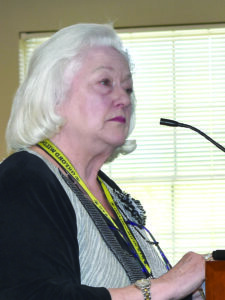Oxford has ‘robust’ plans, still room for improvement
By Don Rush
Last Monday, May 8, the first of two reports to come from Guidepost Solutions on threat assessment, safety protocols and what led up to the Nov. 30, 2021 mass shooting at Oxford High School where four students, Madisyn Baldwin, Tate Myre, Justin Shilling, and Hana St. Juliana, were shot and killed, and six other students and one teacher were wounded.

On Thursday, Guidepost hosted three town hall meetings to go over their first report and answer questions from the community. The meetings were staggered throughout the day with a late morning session at the Oxford Township board meeting room and two more sessions in the afternoon and evening at Oxford Middle School. Between all three meetings, about 40 people attended. The meeting was by Bradley Dizik, Executive Vice President at Guidepost Solutions, who was introduced by Oxford Schools Superintendent Dr. Vickie Markavitch. Dizik then made about a 15 minute slide presentation before answering a handful of questions from the audience.
Guidepost’s review consists of two reports. This first report released last week only addressed the District’s current school safety and security policies and practices, including for threat and suicide assessment and physical security. This report did not address the district’s school safety and security policies and practices in place at the time of the shooting, interactions with the shooter before the shooting, or actions before, during, and after the shooting — those areas of investigation will be addressed in a subsequent report to be released sometime in the future.
According to their first report, “While the (Oxford School) District’s current suicide intervention and threat assessment policies, procedures, and practices are robust, there is still room for improvement. Guidepost assigned a prioritization level to each observation based on the perceived level of urgency that the observation commands in relation to threat and suicide assessment policies, procedures, and practices. This approach supports a phased review, corrective action schedule, and program that can be adopted by the District to substantiate future fiscal budgeting for corrective action by prioritization.”
In their report, Guidepost pointed out eight observations from their investigation from a priority of “medium high” to “low moderate.”
The top three observations to the district’s threat assessment process dealt with Access To Weapons, Inclusion of School Resource Officers (SROs) in The Assessment, and Transition to Navigate360.
According to the report, Guidepost discovered in 2022 and 2023, threat and suicide assessment teams did not consistently document whether they inquired about the students’ access to weapons.

“Of the 44 suicide assessments that the District provided to us to evaluate, the assessment teams documented that they inquired about access to firearms in only two of the cases. As for threat assessments, the assessment team documented that they inquired about access to firearms in three out of the 20 assessments during the winter semester of 2022 and 21 out of the 28 assessments during the fall semester of 2022. The District’s policy appropriately requires assessment teams to inquire about a student’s access to ‘dangerous instrumentalities’ and firearms in threat and suicide assessments, and District staff must be trained to do so consistently.”
The report stated, “Over the past year, there were several occasions where an SRO was not brought into the threat assessment process.” They then recommended, “ . . .With the potential of identifying a weapon in a search and with the importance of having a law enforcement perspective for the safety of students, it is critical that threat assessment teams are reminded – and directed – to include security resource officers in threat assessments and as applicable, suicide interventions.”
In Oxford schools, the SROs are Oakland County Sheriff’s deputies – armed and with arrest powers.
The third higher priority observation by Guidepost dealt with the district’s transition from a paper-based threat assessment process where assessments are kept in binders in the building administrator’s office to an online system known as Navigate360. “ . . .When evaluating potential threats or suicide, context is critical, especially where the student was subject to a previous threat assessment or suicide intervention assessment. With the transition from a paper-based system to an online system, it is important that the district ensure the historical threat assessments and suicide intervention assessments are loaded into the new system.”
The report also indicated the district currently provides threat assessment training for its new model to members of the threat assessment teams, including counselors, social workers, administrators, and SROs, however it should “offer training to other staff members, including teachers and other staff who interact with students (such as bus drivers, coaches, cafeteria workers, or janitors). Such training would be tailored to their individual roles, helping them identify and report on signs and behaviors that may suggest a student needs additional support or an intervention.”
The report also suggested all school personnel “including volunteers, substitutes, coaches, volunteers, and part-time staff, should be trained on ALICE and other emergency protocols.” ALICE is an acronym for Alert, Lockdown, Inform, Counter and Evacuate.
The entire 179 page report can be read online at oxfordresponse.com.

Leave a Reply